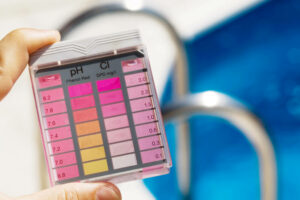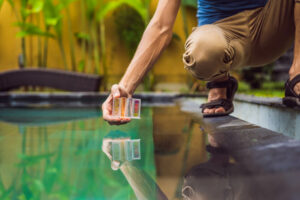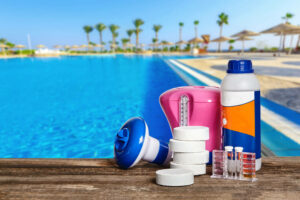What Chemicals Do I Need For A Pool
Dive into the secrets of a crystal-clear oasis as we unveil the essential chemicals you need to transform your pool into a shimmering sanctuary.
From chlorine’s vital role in sanitization to pH balancers that maintain the perfect water chemistry, we’ll guide you through the chemistry of pool maintenance. Discover how these chemicals work their magic, ensuring your pool remains pristine and inviting all season long.
Get ready to unveil the keys to a blissful swimming experience!
The Fundamentals of Pool Chemistry
Maintaining a well-balanced pool requires a basic understanding of pool chemistry. It involves a delicate interplay of various chemicals that work together to ensure the water remains clean, clear, and safe for swimming.
By comprehending the fundamentals of pool chemistry, you’ll be equipped to make informed decisions about the chemicals you need for your pool.
Understanding the Role of Sanitizers
Sanitizers play a crucial role in pool maintenance by eliminating harmful bacteria, viruses, and other microorganisms that can thrive in pool water. The primary sanitizer used in most pools is chlorine.
Chlorine effectively disinfects the water, neutralizing contaminants and preventing the spread of waterborne diseases. Other options include bromine, which is particularly suitable for hot tubs, and salt systems that generate chlorine from salt.
Chlorine: The Primary Sanitizing Agent

Chlorine is the go-to sanitizer for most pool owners due to its effectiveness and affordability. It kills bacteria, algae, and other microorganisms that can lead to cloudy water or pose health risks.
Chlorine can be added to the pool in various forms, such as liquid, tablets, or granules. Regular monitoring and adjustment of chlorine levels are necessary to maintain the proper balance and ensure the water remains sanitized.
Alternatives to Chlorine: Exploring Bromine and Salt Systems
While chlorine is widely used, there are alternatives worth considering. Bromine is a suitable option for pools with high water temperatures, such as hot tubs. It works similarly to chlorine but is more stable at higher temperatures.
Saltwater pools have gained popularity as well. These systems use salt and electrolysis to produce chlorine, providing a milder and more skin-friendly swimming experience.
Balancing the pH: The Key to Water Comfort

pH balance is a critical aspect of pool chemistry. It refers to the acidity or alkalinity of the water and is measured on a scale from 0 to 14, with 7 being neutral.
Maintaining the appropriate pH level (usually between 7.2 and 7.8) is crucial for swimmer comfort and the effectiveness of other chemicals. Low pH can cause skin and eye irritation, while high pH can lead to cloudy water and reduced sanitizer efficiency.
Alkalinity: Maintaining Stability in Your Pool
Total alkalinity measures the water’s ability to resist pH changes. It acts as a buffer, preventing rapid fluctuations in pH levels. Proper alkalinity (typically between 80 and 120 parts per million) ensures that the pH remains stable, allowing the other chemicals to work effectively.
Sodium bicarbonate (baking soda) is commonly used to raise alkalinity levels, while muriatic acid or sodium bisulfate can be added to lower them if necessary.
Calcium Hardness: Preventing Corrosion and Scaling
Calcium hardness refers to the concentration of calcium in the water. It is crucial to maintain the right level to prevent corrosion of pool equipment and surfaces, as well as scaling caused by high calcium levels.
Proper calcium hardness (usually between 200 and 400 parts per million) helps prolong the lifespan of your pool and keeps it looking pristine.
Calcium chloride can be added to raise hardness, while dilution or the use of a sequestering agent can lower it.
The Importance of Cyanuric Acid (CYA) in Pool Maintenance

Cyanuric acid, also known as a stabilizer or conditioner, is vital for protecting chlorine from degradation due to sunlight exposure. It acts as a sunscreen for chlorine, extending its lifespan and reducing the need for frequent sanitizer replenishment.
However, maintaining the appropriate CYA level (typically between 30 and 50 parts per million) is crucial, as excessive amounts can reduce chlorine’s effectiveness and lead to water cloudiness.
Shock Treatment: Revitalizing and Super Chlorinating Your Pool
Shock treatment involves adding a highly concentrated dose of chlorine or a non-chlorine oxidizer to the pool to eliminate chloramines, algae, and other organic contaminants. It helps restore water clarity, neutralize unpleasant odors, and enhance the performance of sanitizers.
Shocking the pool is recommended periodically, especially after heavy pool usage, heavy rainfall, or when facing water clarity issues.
Algaecides: Tackling Unwanted Growth
Algae can be a persistent nuisance in pools, leading to green, slimy, or cloudy water. Algaecides are chemicals specifically designed to combat and prevent algae growth. They work by disrupting the algae’s cellular structure, effectively killing and preventing their spread.
Algaecides are available in various forms, including copper-based and non-metallic options, and can be used as a preventive measure or to address existing algae problems.
Clarifiers and Flocculants: Enhancing Water Clarity
Clarifiers and flocculants are additives used to improve water clarity by addressing small particles and debris that can make the water hazy or dull. Clarifiers work by coagulating these particles, making them easier for the filter to capture.
Flocculants, on the other hand, cause the particles to clump together, allowing them to settle to the bottom for manual removal. These chemicals can be valuable tools in achieving and maintaining sparkling clear pool water.
Stabilizers: Protecting Chlorine from UV Degradation
Stabilizers, also known as sunscreens for chlorine, protect the sanitizer from the degrading effects of sunlight. They reduce chlorine loss due to ultraviolet (UV) rays, helping it remain effective for a longer period. Common stabilizers include cyanuric acid (mentioned earlier) and its derivatives.
By maintaining the appropriate stabilizer levels, pool owners can reduce chlorine consumption and improve water sanitation.
Metal and Stain Removers: Banishing Unsightly Stains
Metals, such as iron and copper, can find their way into pool water from various sources, including filled water or corrosion of pool equipment. These metals can cause unsightly stains on pool surfaces.
Metal and stain removers are specially formulated chemicals that chelate or sequester these metals, preventing them from staining the pool. Regular use of these products can help keep your pool looking clean and stain-free.
Testing Kits: Monitoring Chemical Levels for a Healthy Pool

Regular testing of pool water is crucial to maintain the appropriate chemical balance. Testing kits allow you to monitor various parameters, such as pH, chlorine levels, alkalinity, and more.
These kits come in different forms, including test strips and liquid reagents, and provide accurate readings to guide you in adjusting chemical levels as needed.
By regularly testing and adjusting chemical parameters, you can ensure a safe and enjoyable swimming environment.
Tips and Best Practices for Safe Handling and Storage of Pool Chemicals
Working with pool chemicals require attention to safety precautions. This section covers essential tips and best practices for the safe handling, storage, and use of pool chemicals. It includes guidance on proper protective equipment, safe storage areas, appropriate handling procedures, and what to do in case of spills or accidents.
Following these guidelines will help ensure your pool chemical management is conducted with safety in mind.
Here’s a table showcasing different chemicals commonly used in pool maintenance, along with their effects, which type of pool they are more effective for, and when they typically need to be renewed:
| Chemical | Effects | More Effective for | Renewal Frequency |
| Chlorine | Sanitizes the pool water, killing bacteria and viruses | All types of pools | Daily or as needed |
| Bromine | Alternative sanitizer, effective at higher temperatures | Hot tubs and indoor pools | Every 2-4 weeks |
| Salt (Sodium Chloride) | Used in saltwater systems to generate chlorine | Saltwater pools | Ongoing as needed |
| Cyanuric Acid (CYA) | Protects chlorine from degradation by UV rays | Outdoor pools exposed to sunlight | Every 3-6 months |
| pH Increaser (Soda Ash) | Raises pH levels for optimal water balance | Pools with low pH levels | As needed based on testing |
| pH Reducer (Muriatic Acid) | Lowers pH levels for optimal water balance | Pools with high pH levels | As needed based on testing |
| Alkalinity Increaser | Raises alkalinity levels, stabilizing pH levels | Pools with low alkalinity levels | As needed based on testing |
| Calcium Chloride | Increases calcium hardness to prevent corrosion and scaling | Pools with low calcium hardness levels | As needed based on testing |
| Algaecide | Prevents and treats algae growth in the pool | Pools prone to algae growth | Every 1-2 weeks |
| Clarifier | Enhances water clarity by coagulating particles | Pools with cloudy water or small debris particles | Every 1-2 weeks |
| Flocculant | Causes particles to clump and settle for easy removal | Pools with large debris particles and severe cloudiness | As needed based on clarity |
| Metal and Stain Remover | Helps eliminate metal stains and discoloration | Pools with metal or stain-related discoloration issues | As needed based on stains |
| Non-chlorine Shock | Oxidizes and removes organic contaminants in the water | Pools where high chlorine levels are not desired | As needed based on usage |
| Testing Kits | Allows for regular monitoring of chemical levels | All types of pools | Ongoing as needed |
This comprehensive table provides an overview of different chemicals used in pool maintenance, along with their effects, the types of pools they are more effective for, and when they typically need to be renewed.
Understanding the renewal frequency helps pool owners stay on top of their maintenance routines and ensures optimal water quality and clarity throughout the pool season.

In conclusion,
maintaining a clean and balanced pool requires the use of various chemicals to address specific needs.
By understanding the effects of each chemical and which type of pool they are more effective for, pool owners can make informed decisions and keep their pools in optimal condition.
Regular renewal of chemicals and adherence to proper testing and maintenance schedules are crucial for ensuring water quality and clarity. With the right knowledge and consistent care, you can enjoy a safe and refreshing swimming experience all season long.
So, dive in with confidence and make a splash in your well-maintained pool oasis!














